
sinking fish feed machine
RICHI sinking fish feed machine is mainly used to produce sinking fish food, suitable for bottom-dwelling fish or shrimp. The fish pellet making machine generally adopts a ring die fish feed machine.
The fish feed produced by this sinking fish pellet making machine belongs to the sinking type fish feed with high density and low water content. When the ring die sinking fish food pellet making machine is used to produce fish feed, the feed yield is high and the production cost is low.
- Model: SZLH
- Conditioner: 2 or 3 layer
- Capacity: 0.6-27 T/H
- Power: 37-315 KW
- Sinking fish feed machine price: 10,000 – 100,000 USD
Today’s demand for cost-effective yet high quality, high-performance feeds make it clear that producing the best feed requires specialized fish feed processing technology. Richi Machinery is one of the world’s leading sinking fish pellet making machine suppliers of technologies, sinking fish feed production systems , and services relating to advanced industrial sinking fish feed mill equipment for the aqua feed industry.
Features of sinking fish pellet machine
At present, most of the fish feed is hard pellets, and the performance of the sinking fish pellet machine plays a very important role in the quality of pellets.
There are many varieties of sinking fish feed machines on the market, and the performance is quite different, especially the selection of the parameters of the pressing roller and the pressing die of the sinking fish food pellet maker, the thickness and compression rate of the pressing die should be paid attention to in the selection.
Compared with the die used for livestock and poultry pellet feed, the die used to make aquatic pellet feed must be thick and the compression rate is high.
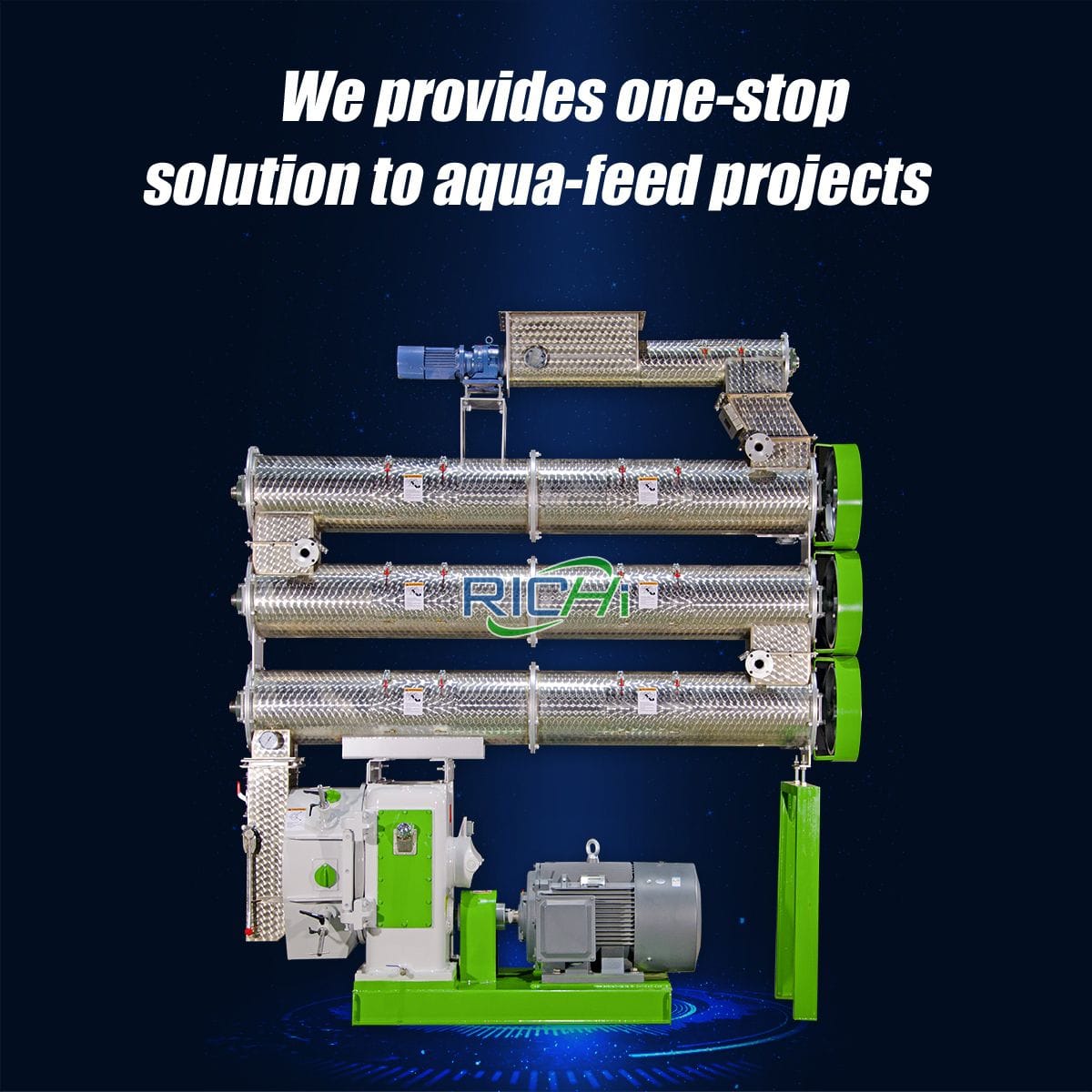
Sink fish feed machine with three-layer conditioner

sinking feed machine with double-layer conditioner
- Suitable for the production of feed for common freshwater fish such as crucian carp, grass carp, herring and silver carp. The unique double-layer or triple-layer jacket conditioner is used to achieve better heat preservation and conditioning effect;
- This sinking fish pellet machine model can be equipped with various auxiliary equipment such as ring die lifting device and self-service grease lubrication system, which is convenient, worry-free and fast. In particular, the speed of the ring die is optimized according to the characteristics of the fish feed, resulting in higher output and better quality;
- RICHI sinking fish feed pellet machine requires the cutter mechanism to be fixed on the box, which is convenient for observation and positioning, and there is no need to withdraw the cutter mechanism when opening the door cover.
- The hole diameter of the sinking fish food pellet machine ring die is generally Φ1.5~3mm, and the length-diameter ratio is generally 11. : 0~13:0 (can be changed according to user needs), the cutter is close to the outer surface of the ring die to ensure that the ring die can be discharged at one time.

We strive to provide our customers with the newest technologies to ensure better and more efficient production, minimizing sinking fish feed machine operation cost, maximizing fish feed mill plant energy efficiency and environmental protection considerations.
Parameters and price of sinking fish feed machine
The sinking fish pellet machine price is usually 10,000-100,000 USD. Regarding the question of how much is the sinking fish pellet making machine, different models and different configurations have different prices.
We also provide some parts and structure customization services. Therefore, you need to make sinking fish feed pellet making machine selection and quotation according to your production requirements.
You can submit production requirements such as raw materials and output to customer service to obtain selection plans and quotation budgets.

| Model | Capacity(TPH) | Main Motor Power(kw) | Feeder Motor Power(kw) | Conditioner Power(kw) | Dia.of Ring Die(mm) | Final Pellet(mm) |
|---|---|---|---|---|---|---|
| SZLH250 | 0.6-1.4 | 22 | 0.75 | 1.5 | 250 | 1.5~12 |
| SZLH320 | 1.8-2.8 | 37 | 1.5 | 2.2 | 320 | 1.5~12 |
| SZLH350 | 3-5 | 55 | 1.5 | 3 | 350 | 1.5~12 |
| SZLH420 | 4.8-8.5 | 90 | 1.5 | 7.5 | 420 | 1.5~12 |
| SZLH508 | 6-12.5 | 132 | 2.2 | 11 | 508 | 1.5~12 |
| SZLH558 | 9-17.5 | 180/200 | 2.2 | 11 | 558 | 1.5~12 |
| SZLH558D | 8.4-15.5 | 160/180/200 | 1.5 | 7.5 | 558 | 1.5~12 |
| SZLH678 | 12-21 | 220/250 | 2.2 | 11 | 678 | 1.5~12 |
| SZLH678D | 9-17.5 | 200/220/250 | 2.2 | 11 | 673 | 1.5~12 |
| SZLH768 | 15-28 | 280/315 | 2.2 | 11 | 768 | 1.5~12 |
| SLZH858 | 15-30 | 280/315 | 2.2 | 15 | 858 | 1.5~12 |
RICHI MACHINERY
Project of sinking fish feed machine
Adhering to the corporate core values of “creating value and sharing value”, Richi Machinery has determined the strategy of “extending to the product industry chain”, “taking customers as friends” and “building a service system”, focusing on floating and sinking fish feed pellet mill research and development, focusing on customer value creation , focusing on a higher-level business model to achieve a win-win situation with customers. (Related case: Fish Food Production Line In Iran)

Uzbekistan 5 t/h sinking fish feed Pellet machine project
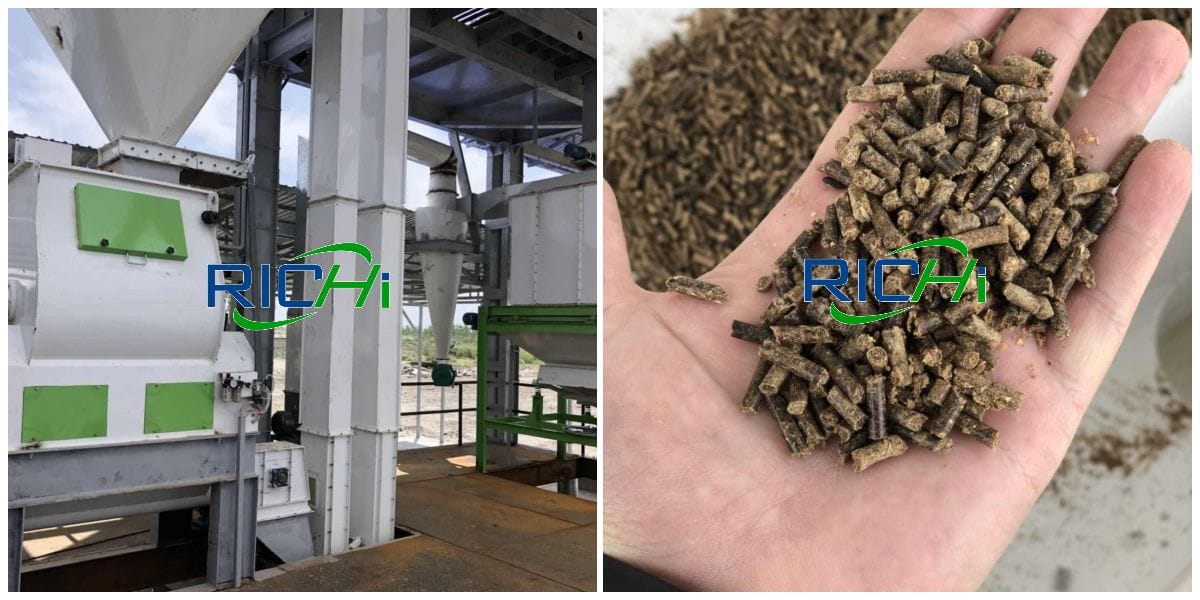
Thailand 1 t/h sinking fish feed Making machine project
Our sinking fish feed machine and sinking fish feed mill plant solutions are simple and effective. We strive to be a “one-stop-shop” supplying all your needs. Our packages are tailor-made to suit the specific requirements of our customers, whether it is our extensive knowledge or expert engineering along with individual process machines, complete fish feed processing lines, or spare parts and service availability.

Working principle of sinking fish feed machine
—— RICHI MACHINERY ——
The process of sinking fish food pellet making machine is to remove the iron from the powdered compound feed through a magnetic separator, then send it to the stirring and conditioning system through a continuously variable screw feeder, and stir it with the steam (sometimes molasses and fat) added at the same time. Mixed, so that the protein and starch in the feed are diluted by water under the action of heat, and become a material with strong plasticity, and the crude fiber is softened by heating.
At this time, the feed moisture reaches 15%~17%, and the temperature is 65~85℃. The quenched and tempered material is sent between the running ring die and the working surface of the sinking fish pellet machine pressing roller. The rotating die drives the roller to rotate through friction with the material. (Related product: fish feed extruder machine)
Under the strong extrusion of sinking fish pellet machine, the material overcomes the resistance of the hole wall and is continuously extruded from the die hole in strips. When extruding, the cutter installed outside the die is cut into granules of suitable length, and the position of the cutter can be adjusted to control the length of the granules.
Sinking fish feed machine is the key link in quality assurance of pelleted feed. Mastering the working principle of sinking fish feed pellet machine can improve the pelleting effect and improve the palatability and nutritional balance of pelleted feed, which is also the basis of feed quality research.
Our sinking fish feed pellet mill program ensures the sinking fish feed achieves these properties; giving it the appropriate sinking attributes necessary to deliver the fish food to the right location in the water where each of the different species of aquatic eats.
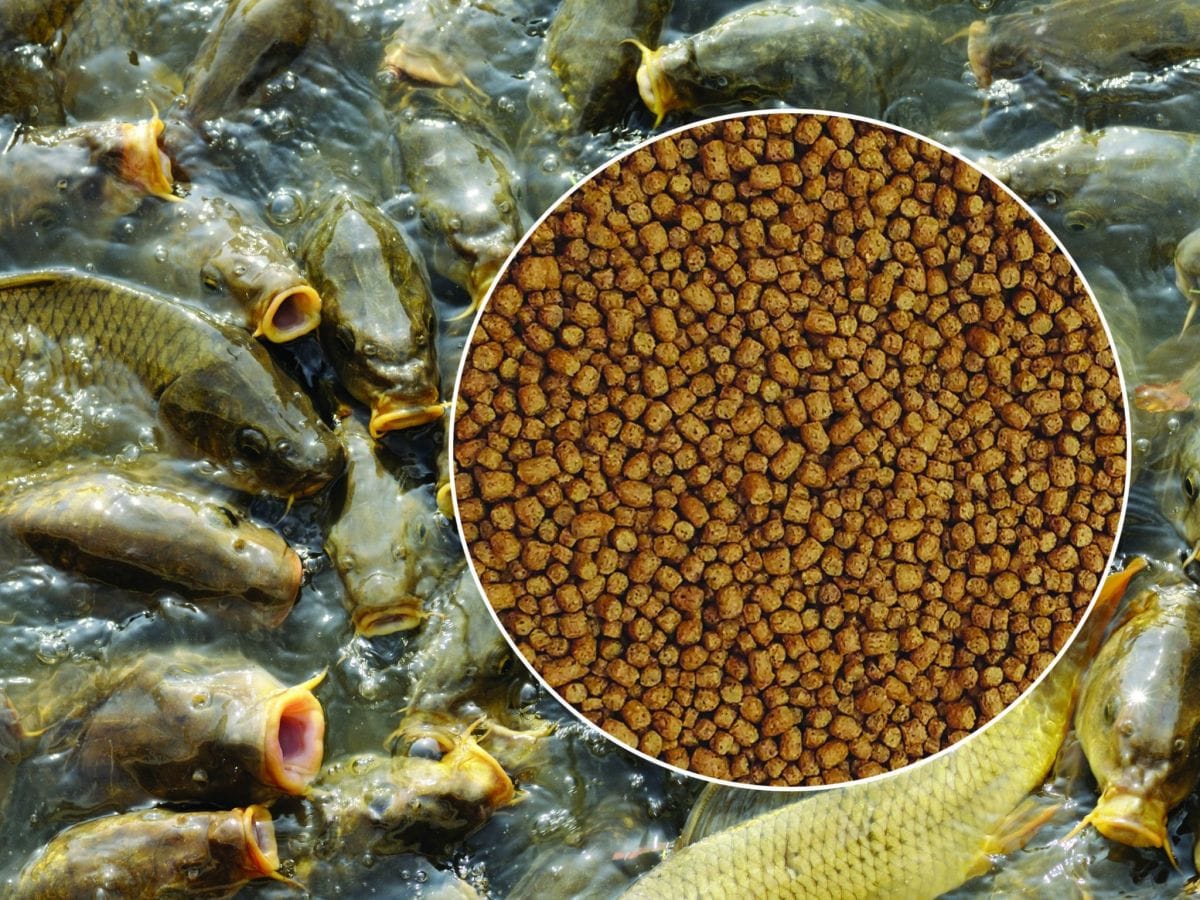

The core of sinking fish feed machine —— conditioner
Ring die sinking fish pellet machine is one of the most advanced sinking fish feed pellet machines, which is a machine that uses the bonding force between materials to compress fish feed raw materials into desired shapes.
Before pressing, the material must be conditioned and tempered, and the quality of conditioning is directly related to the granulation process. Since most of the sinking fish food pellet makers are currently used in the feed production industry, most of the conditioning is for feed production.
Conditioning is one of the important factors affecting the quality of pellet feed. Different quenching and tempering processes and equipment have different quenching and tempering process parameters (conditioner speed, quenching and tempering time, etc.), so the quenching and tempering effect is also quite different.
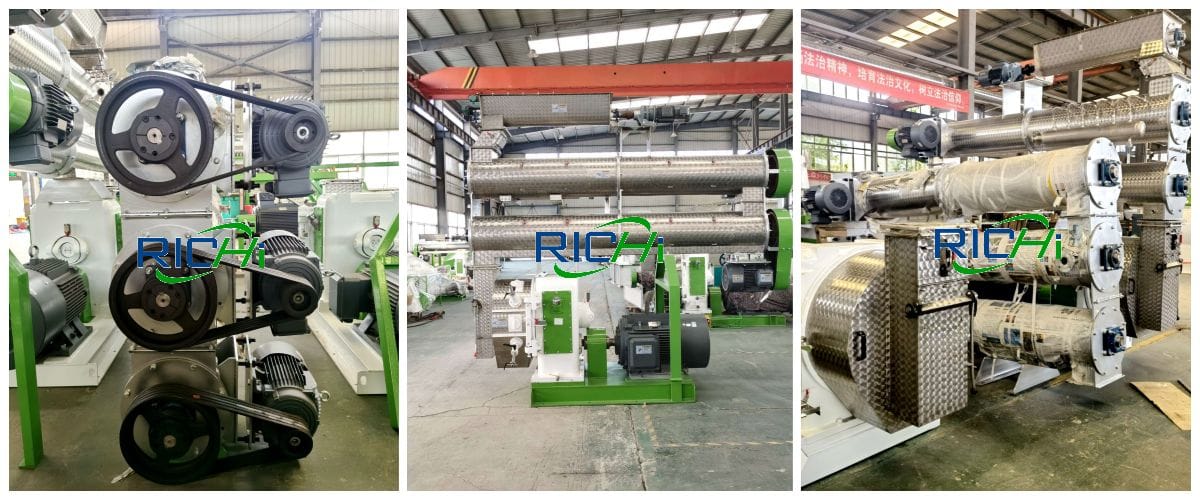
Within a certain range, the longer the sinking fish feed machine conditioning time and the higher the conditioning temperature, the higher the gelatinization degree of starch in the raw material, the stronger the cohesion, and the better the water resistance of the feed. Generally, the conditioning time of aquatic feed is 40 ~150 seconds, the tempering temperature is 80~100℃.
The main purposes of conditioning sinking fish feed are as follows:
01
The material is softened by sinking fish pellet machine steam heating and has more plasticity, which is conducive to extrusion forming, reduces the wear on the die and the pressure roller, and improves the production efficiency.
02
Through the hydrothermal action, the starch in the feed can be fully gelatinized, the protein can be denatured, the amylase can be converted into soluble carbohydrates, and the digestion and utilization rate of the feed can be improved.
03
Improve the density of pellet feed, with smooth appearance, not easy to be eroded by water, and increase the stability in water.
04
The high temperature effect of the sinking fish feed machine conditioning process can kill harmful bacteria such as Escherichia coli and Salmonella in the feed, improve the safe storage performance of the product, and be beneficial to the health of aquatic animals.

Different raw materials have different characteristics, and different formulas and products have different quality requirements. As far as the production of aquatic pellet feed is concerned, higher gelatinization degree and water stability are required. (Related product: Twin Screw Extruder For Sale)
According to the characteristics of the fish feed raw materials in the formula and the quality requirements of the product, the appropriate conditioning parameters should be selected, that is, the sinking fish feed machine conditioning temperature, the amount of water added, and the conditioning time. On the premise that the moisture and temperature are satisfied, the sinking fish pelley feed machine conditioning time must be extended.

Our sinking fish feed pellet mill machine is equipped with a multi-channel conditioner, generally three channels, and its structure adopts an elongated double-layer jacket conditioner. The total length is about 8m, and the material residence time is about 2min. The length of the sinking fish pellet feed making machine conditioning auger and the number of channels of the conditioner can be arbitrarily selected and superimposed according to the requirements of the production of feed varieties.
The fish farming industry is experiencing considerable growth in all regions of the world, creating an ever increasing demand for high-quality fish feed. The key to successful fish farming lies in correctly formulating a homogenous blend of ingredients with the right physical properties to match the unique feeding characteristics of the species being fed.
Why is sinking fish feed machine equipped with three-layer conditioner?
Generally speaking, the two-layer conditioner sinking fish feed pellet mill can also be used for the processing of sinking fish feed. However, if you want your feed to be more competitive, then we will responsibly recommend the three-layer conditioner sinking fish food pellet machine to you.
The three-layer conditioner is used for curing before pelleting, which can ensure that the feed is fully gelatinized and improve the water stability of the feed. Generally, it can be kept in water for more than 2 hours without being dissolved, which not only improves the palatability and digestibility of the feed, but also ensures the stability of the feed. Aquatic animals have a longer feeding time, so the residual amount of feed in the water is less, which can prevent water pollution.
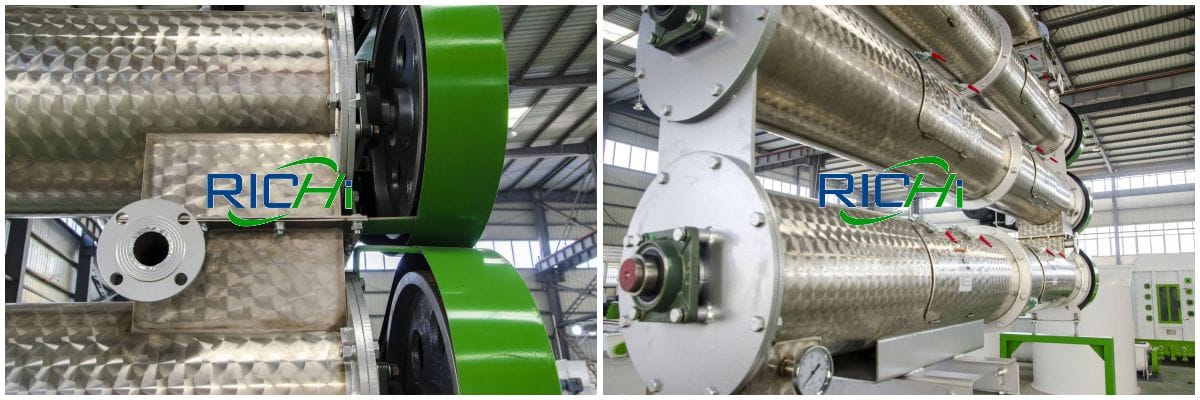
In the production of fish feed, the use of multi-channel conditioner can ensure that the aquatic feed has sufficient conditioning time before pelleting, thereby improving the water stability and product quality of the aquatic feed.
In addition, since aquatic animals such as soft-shelled turtles, crabs, prawns, and eels have higher requirements for starch gelatinization and water resistance of feeds, stronger conditioning measures are required.
The most used method is to add a post-curing process after granulation, that is, to change the previous pellet feed into the cooler for cooling immediately after it is made, and add a post-curing process between the pellet mill and the cooler to further keep the pellet feed warm.
It can be fully matured to avoid the phenomenon of external ripening and internal growth of granular bait, which greatly increases the bioavailability of granular bait.

The pellet stabilizer is to put the just-pressed pellets into the stabilizer immediately for heat preservation treatment, because the temperature of the pellet bait can reach about 85 ℃ when it is out of the mold, so that the hot granules can last for a period of time under high temperature and high humidity, so that the starch in the pellet bait fully gelatinized, the protein is fully denatured, especially the starch on the surface is fully gelatinized and hardened, which improves the water resistance.
Our easy-to-operate sinking fish feed plants, adaptable systems, short implementation times and proven performance make us the stand out partner for the aqua food production.

Conditioning and ring die of sinking fish feed machine
Sinking fish feed making machine conditioning is to perform hydrothermal treatment on the mixed material before granulation, so that part of the starch is gelatinized, protein is denatured, and the material is softened to facilitate molding, thereby improving the quality of pellet feed, long conditioning time, high starch gelatinization degree, good pellet cohesion, and high water stability. Generally, the sinking fish pellet machine ring die is small and the aspect ratio is large, the particle surface is smooth and the molding is good.
The compression ratio of the ring die in the sinking fish feed machine has a great influence on the water resistance of the feed. Within a certain range, the larger the compression ratio of the sinking fish feed pellet mill ring die, the tighter the feed is pressed and the better the water resistance of the feed; on the contrary, the higher the compression ratio of the sinking fish food pellet making machine ring die, the better the water resistance of the feed. Smaller, the looser the feed will be, and the worse the water resistance of the feed will be. Generally, the compression ratio of ring die is 1:(8~17).
The effect of sinking fish feed pellet mill ring die compression ratio on feed water resistance is shown in the following table:

From the relationship between the quenching and tempering temperature and the size of the sinking fish feed machine ring die.
01
Using a small ring die (the diameter of the die hole is 3mm and the aspect ratio is 15:1) for granulation, the quenching and tempering temperature has no significant effect on the forming rate of the finished product;
02
Using a large ring die (the diameter of the die hole is 4∙8mm, and the aspect ratio is 13:1) for granulation, the quenching and tempering temperature has a very significant influence on the forming rate of the finished product.
The higher the quenching and tempering temperature, the higher the forming rate. Therefore, when using a small ring die (die hole diameter≤3∙0mm), low temperature quenching and tempering should be used, because high temperature quenching and tempering will bring too much moisture, which is easy to cause blockage, especially when using a 1∙5mm ring die.

It is advisable that the quenching and tempering temperature should not be higher than 70℃; when using a large ring die (die hole diameter≥ 4∙0mm), high temperature quenching and tempering should be used.
Whether it’s sink or float, Richi Machinery fish feed making machines will keep your aqua feed pelleting production high quality. The Pelletizing Control Systems will perfect product density and sinking speed so your aqua feed is always a big splash.

Steam pressure and feeding speed of sinking fish feed machine
Generally, the higher the pressure, the longer the water-resistant time of the pelleted feed, but the steam pressure should not exceed 0∙5MPa comprehensively. It is produced with a sinking fish feed pellet making machine ring die of φ2∙5mm, and the feeding speed is preferably 300-400r/min. Too high or too low will affect the water resistance of the feed.
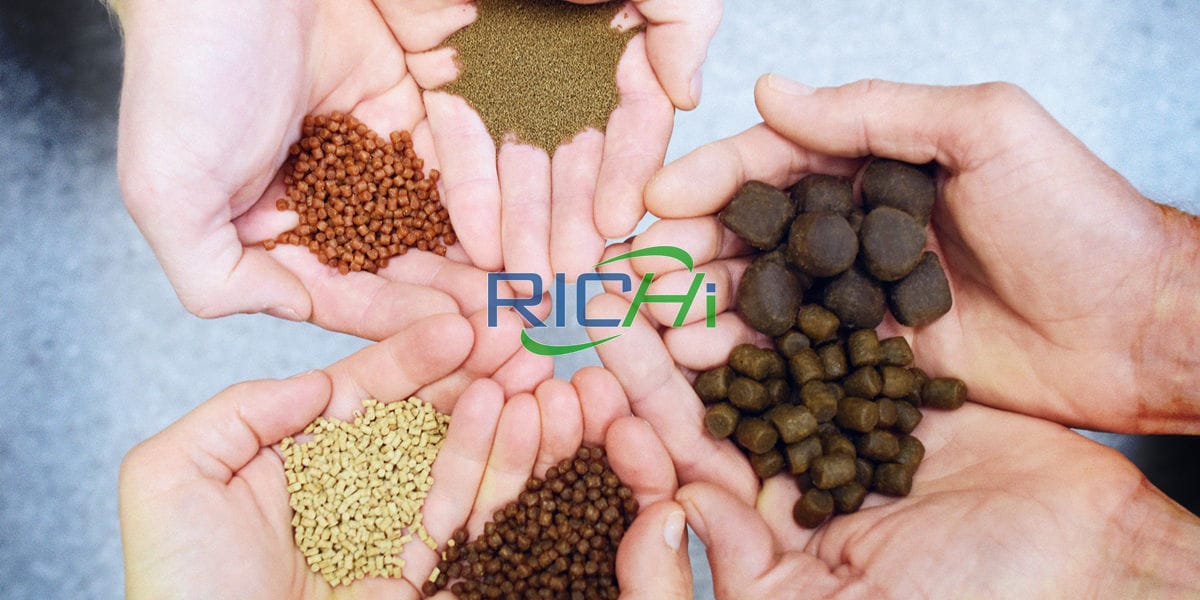
Gap between ring die and press roller of fish feed pellet machine
Stress is an important factor affecting the water tolerance of feed. If the gap between the die and the roller is too large, the pressure will be low, resulting in low hardness, poor molding and poor water resistance of the pellet feed; In production, the gap between the pressure roller and the ring die should be kept at about 400-500μm.
Selection of accessories for sinking fish feed pellet making machine
01 Selection of conditioner
①Selecting the lengthening conditioner For a certain installation angle, the longer the cylinder, the longer the conditioning time. Since the length of the single-layer conditioning cylinder is generally not more than 4m, three layers are generally used, and the total length can reach 9m, and the conditioning time can be up to 2min.
②Choose the multi-layer stacking combined jacketed stressor. The addition of steam between the jackets of such conditioners acts as a thermal insulation, which can effectively reduce heat loss and improve the temperature and maturation degree of the conditioned powder.

③Use a dual-shaft differential conditioner. Due to the differential motion of the two shafts with different rotation speeds and opposite directions of rotation, the materials, steam and liquid are thrown upward from the middle of the two stirring shafts under the stirring of the paddle blades and form convection, and the materials are fully sheared, staggered and mixed. The quality time can be up to 180s, and the starch has a high degree of ripening.
The cooker is a cylinder equipped with a vertical rotating shaft and a stirring blade, and the wall of the cylinder can be insulated. It is placed between the paddle conditioner and the sinking fish feed pellet making machine. After adding 4% to 5% steam in the paddle conditioner, the material enters the simmer for heat preservation. It can stay for 10-20min, and the quenching and tempering effect is good, which is beneficial to the improvement of particle quality and yield.
02 Selection of sink fish feed machine ring die
The sink fish pellet machine ring die is the key part of the pellet machine, which has a direct impact on the quality of the extruded pellet feed. Therefore, it is very important for feed producers to understand the characteristics of the ring die and make the correct selection, rational use and effective maintenance of the sinking fish feed machine ring die. Users should pay attention to the following aspects when choosing ring die:
- Ring die material;
- Ring die opening rate;
- Long diameter ratio of ring die;
- Die hole roughness.

①Material: There are mainly three types of carbon structural steel, alloy structural steel and stainless steel. Stainless steel ring die is widely recognized by users because of its good stiffness and toughness, good wear resistance and corrosion resistance, and long service life.
②In terms of porosity: the porosity is the ratio of the die hole area to the working area of the sinking fish feed pellet making machine ring die. The larger the opening rate, the higher the output. On the premise of satisfying the strength of the ring die, try to choose a ring die with a high opening rate to reduce energy consumption.
③In terms of aspect ratio: the compression ratio of sinking fish food pellet making machine ring die refers to the ratio of the effective length of the ring die hole to the minimum diameter of the ring die hole. The larger the aspect ratio, the stronger the extruded pellet feed and the lower the output.
Generally speaking, the compression ratio between 9 – 13 should be selected for livestock and poultry feed; the compression ratio between 13 -16 should be selected for fish feed; the compression ratio between 20 -25 should be selected for shrimp feed; The compression ratio between 7 -9 should be selected for feed; the compression ratio between 6 and 9 should be selected for pasture and straw feed.
④Roughness: Roughness is also an important indicator to measure the quality of the sinking fish feed machine ring die. Under the same compression ratio, the larger the roughness value, the greater the extrusion resistance of the feed and the more difficult it is to discharge the material. Excessive roughness also affects the quality of the particle surface. A suitable roughness value should be between 0.8 -1.6.
At present, the formula of each feed factory is different, the raw materials used are different, and the sinking fish feed maker machine pelletizing process is also different. The user comprehensively considers the actual situation and selects the appropriate ring die to ensure the efficient operation of pelleting.
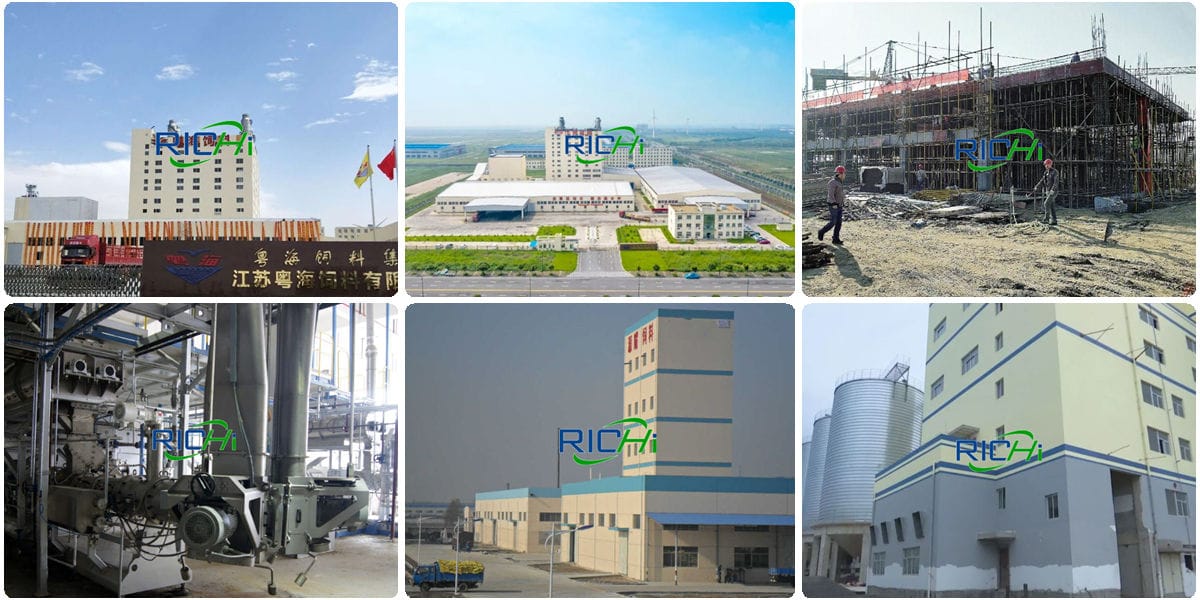
03 Selection of pressing roller shell
The pressure roll shell is generally made of wear-resistant alloy material by gold processing and heat treatment. At present, there are mainly three kinds of tooth surface pressure roller shells: honeycomb shape, tooth groove shape, and tooth groove shape with edge sealing. Honeycomb and toothed rollers are mainly used for pelletizing livestock and poultry feed.
The advantage of the honeycomb press roller is that the ring die wears evenly, but the coil performance is poor. The alveolar pressure roller has good coiling performance and is widely used in feed mills, but the wear of the ring die is not uniform. The toothed roller with edge-sealing is mainly suitable for the pelleting of aquatic products, and it is not easy to slide to both sides when the feed is squeezed.
The wear of the pressure roller will lead to the blockage of the machine, the uneven length of the flower material, and the uneven length of the material. The rational selection and use of the pressure roller is also an important factor affecting the quality and output of the pellets fish food that sinks.

Our core competencies, leading technologies, and international business units work together in perfect unison. The RICHI staff commitment and dynamics truly distinguish us from other suppliers. Experienced project managers teamed with specialized, subject area experts ensures that we exceed your expectations every time.
Auxiliary equipment of sinking fish feed machine
The design of the pelleting process and the selection of related equipment are important factors that affect the quality of aquafeed. At present, the equipment used for granulation is sinking fish feed machine, and the related equipment after granulation is pellet cooler, pellet crumbler, grading screen, etc.
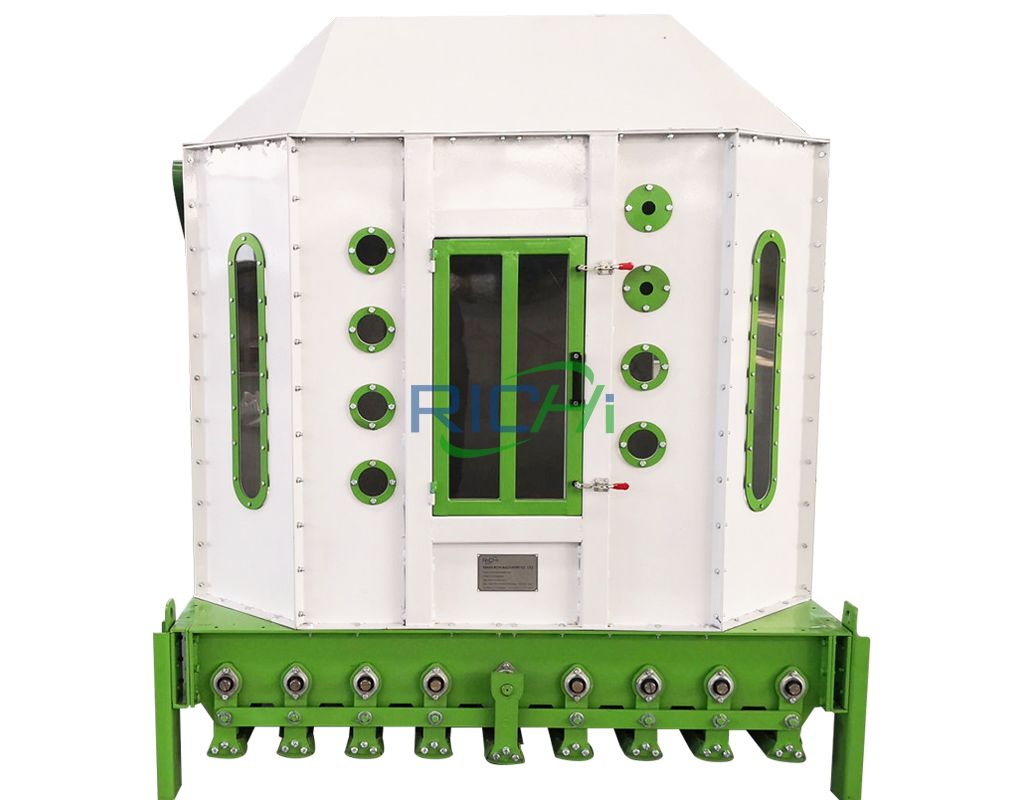
Richi Machinery
Pellet Cooler machine
The hot pellets from the sinking fish pellet machine need to be cooled. The key to cooling aquatic feeds is not to cool them quickly, so as to avoid cracks on the surface of the pellets and damage the water resistance of the pelleted feed. At present, the ideal cooling equipment is a counter-flow pellet cooler machine and a horizontal cooler. However, the horizontal pellet cooler occupies a large area, so the corresponding cooling equipment should be selected according to the space and area of the workshop.

Richi Machinery
Pellet Crumbler
In the production of sinking fish food, the use of crubling methods to produce small pellets affects water resistance, and with the improvement of pelleting technology. If a sinking fish feed machine is used to produce feed, it can be crumbled to obtain smaller pellets to meet the needs of young aquatic animals, which can increase productivity and save energy. An essential prerequisite for the production of high-quality crumbled granules is the availability of high-quality, well-cooled fish food that sinks.
Richi Machinery is unique in their ability to manufacture and supply every sinking fish feed pellet machine for aqua feed production. Within-depth knowledge of each key fish feed production process, we provide a compatible and advantageous sinking fish feed production plant solution, from raw material intake to finished feed bulk loading.
fish feed production process and formula
Starch mainly plays the role of binding and is a key factor affecting sinking fish feed machine granulation and shaping. The main raw materials that provide starch in aquafeed are wheat, flour, secondary flour and corn.
In fish ring molding pellets, the above-mentioned raw materials account for 12% to 18%; crustacean ring molding pellets require flour≥20%, and for manufacturers with backward grinding and tempering processes, the addition of binders may also be involved.
When ring-molded pellets are added with more than 3% of pure fat, the hardness of the feed is significantly reduced, but the oil contained in the raw material itself leaks out during the extrusion process, which is beneficial to granulation. The recommended crude fat for ring-molded pellets is ≤8%.

In addition to the raw material’s own fat, the fat of the feed can be added in three steps, including mixing, conditioning, and post-spraying. The addition of grease in the fish feed mixer should be preheated, ≥48℃, and the addition amount is ≤5%, otherwise it will affect the sinking fish feed machine granulation.
The method of oil injection in the conditioner is relatively rare, and the addition amount is generally <3%; post-spraying is commonly used for puffed materials This link is set after drying and before cooling, which is convenient for the feed to inhale the oil. The normal pressure spraying amount should be ≤5%, and the vacuum spraying amount can reach 20%.
The application of pellet feed in aquaculture has promoted the development of the aquaculture industry towards high density and intensification.
In order to improve the conversion rate of feed, improve the water environment and improve economic benefits, the aquaculture industry has been improving the quality of pellets by optimizing the feed formula and selecting the best sinking fish pellet machine.
Closely related to product quality are powder particle size, mixing uniformity, sinking fish food pellet size, strength, surface finish and stability in water.

Through outstanding performance, mastery of key fish food manufacturing process technologies, and fish feed production plant engineering capabilities, Richi Machinery has become a leading global supplier of sinking fish feed machine and fish feed plant systems.
Which is the best way to process fish feed: Pelletizing Or Extrusion?
Granulation processing method

Pelletizers were the first processing equipment used to produce fish feed.
The sinking fish pellet making machine can compress the feed to improve the feed conversion ratio. The pelleted feed is compressed with a ring-die sinking fish feed machine at a moisture content of less than 20%. The main factors relevant to the hard particle processing process are temperature, moisture and pressure. The material needs to be conditioned before being granulated, that is, the temperature and moisture of the powder are adjusted by steam in the conditioner.
Whether the moisture and temperature of the material can be adjusted to the best state is related to the granulation performance, particle quality and production efficiency of the material. The amount of steam added is generally about 5%. Increasing the moisture and temperature of the material can promote starch gelatinization and improve the plasticity and lubricity of the material. However, too much moisture, especially the excessive increase of surface moisture, will make the material too soft and the stress will drop. During sinking fish feed machine granulation, the material will slip and overflow between the die and the pressure roller, resulting in blockage of the die hole.

For ordinary steam moisture conditioning devices, the material stays in the steam conditioning chamber for 15-20 seconds, which can meet the needs of material surface moisture adjustment, but the conditioning time for fish and shrimp feed can be as long as 75-90 seconds.
Generally, steam increases the temperature of the material by about 10℃, and the moisture increases by 1%. The temperature of the quenched and tempered material reaches 75-80℃, and the moisture content reaches 16%-17%. In order to raise the temperature higher without causing too much moisture, the added steam should be dry saturated steam. When the pellets are pressed out into the cooler, they are in constant contact with the surrounding unsaturated flowing air through the cooling fan, resulting in the dual effects of cooling and precipitation.
Due to the nutritional needs of fish and shrimp, fat or molasses should be added when processing hard pellet feed, which is generally added when the powder is mixed, but it has a great impact on the pelletizing performance of the feed. Therefore, the more advanced process is to add oil or molasses by spraying the surface of the particles, which not only meets the nutritional needs of fish and shrimp, but also increases the protective effect of the pellet. For some trace ingredients that should not be added during the sinking fish pellet machine granulation process, they can also be dissolved in fat or emulsified and sprayed to avoid heat damage.

01 The advantages of sinking fish feed pellet processing:
The output is high, the sinking fish feed machine investment is low, the extruded pellet feed does not need to be dried, and can be sold as a commodity after cooling and dissipating the temperature. Compared with the processing of puffed pellet, it has low cost and less damage to nutrients.
Main considerations for sinking fish feed pellet processing:
For the processing of fish food that sinks, with the goal of ensuring water resistance, the process should be further optimized in terms of raw material conditioning, temperature, moisture, pressure, and the selection and treatment of binders.

02 improvement of existing aquatic hard pellet feed production – post-curing process
The post-curing process specifically refers to putting the aquatic hard pellet feed into the sinking fish feed machine, and then treating the feed in terms of temperature and humidity. The whole sinking fish food manufacturing process will last for 1 hour. Using this method, the particle components in starch can be greatly decomposed, and the digestibility of the starch in the feed can be improved by aquatic animals, thereby leading to the safety of water quality.
This link plays a very important role in the aquatic sinking fish food manufacturing process, plays an immeasurable role, and is the fundamental guarantee to avoid water eutrophication. Therefore, aquaculture enterprises should actively take a series of effective measures to improve the gelatinization degree of starch components in feed. In the past, the sinking fish feed pellet machine granulation mode for aquafeed still has major defects.
In most cases, the hard granule mode is used, which has extremely poor stability in water and cannot be fully absorbed and utilized by animals. Contaminants, the results outweigh the gains, and the addition of post-curing technology can just improve the degree of maturation of the feed.

It must be said that the existing post-curing process of aquatic hard pellet feed must be continuously improved and upgraded based on the problems reported during the operation, so as to adapt to the sustainable development of the industry.
Richi Machinery strongly committed to excellent performance and the quality of sinking fish feed machine, making us a strong partner for our customers. Our focus is on innovation and keeping up with fish feed processing technological developments in the industry.
Extrusion processing method

Extruded fish feed is the best additive for improving the gelatinization degree of feed starch, which solves a major problem faced by the current aquaculture industry. Due to the many advantages of the puffing method, the application of puffing to produce fish and shrimp bait has become very common in the aquafeed industry. Extrusion can be used to produce floating, sinking, slow-sinking feed and semi-moist aquatic feed, as well as full-fat soybean, suckling pig feed and pet feed. After the feed is extruded, the starch is gelatinized and the protein is textured, which improves the digestibility, reduces the content of anti-nutritional factors, and makes the feed sterilized and water-resistant.
①The pellets processed by puffing have the following characteristics:
The puffed material increases in volume and fuses together, rather than simply pressing the material together like pressed granules. In fact, puffing reduces the microscopic body surface area of the particles, thereby increasing the disintegration resistance of the material in water. (Related post: Floating Fish Feed Making Machine)
Due to the strong shearing action in the extruder type sinking fish feed machine and the steam added in the conditioner and the extruding sleeve, the starch in the granules is basically completely gelatinized, and the protein is partially denatured. This process creates a fully structured matrix in the puffed granules containing soluble sugars and fibers, which increases the volume of the granules and becomes a porous structure that can absorb more fat. Therefore, more molasses and fat can be added to the raw materials during puffing production without affecting the durability of the granules.

Expansion is done in a short-term high temperature process. The result of this short-term high-temperature processing is starch gelatinization, protein denaturation, and inactivation of enzymes that cause deterioration of the feed during storage. Therefore, this method can eliminate the natural toxic substances and reduce the number of pathogenic bacteria in the final product.
In addition, since the traditional granulation requires a starch content of more than 30%, the starch content can be 5%-10% when using puffing to produce granules, which provides more room for the use of low-protein cheap raw materials to replace high-protein expensive raw materials , thereby reducing costs. (Related post: Floating Fish Feed Extruder Machine)
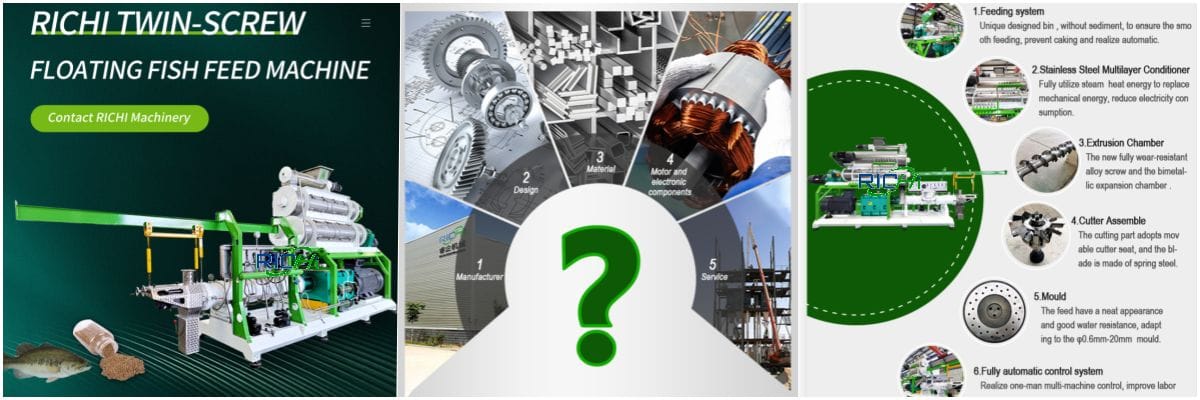
Extruded feed is not only used in aquatic feed because of the gelatinization and gelatinization effect of starch, which makes it possible to add a larger percentage of starch, but also because of the obvious disinfection and sterilization effect of curing effect. Process characteristics.
The floating feed produced by the fish feed pellet extruder has excellent continuous stability and floating properties, and can also produce sinking feed, and can control the speed of the feed sinking, so that the pellets sink slowly without polluting the water quality. And it can control the density of pellet feed to make it float, semi-float, semi-sink and sink, which is suitable for the needs of various aquatic animals.
Requirements for the production of extruded materials: after conditioning, the temperature is 65-95℃, the moisture content is 25%-30%, and the mold temperature is 130-135°C (floating feed), not more than 60℃ (sinking feed); cutter and extrusion The distance of the mold is 0.1-0.2 mm;
Material fineness requirements: the diameter of the sinking fish feed machine die hole is 2-2.5 mm, 95% of the material passes through a 100-mesh sieve, and 100% passes through an 80-mesh sieve; the diameter of the die hole is 3-3.5 mm, 95% of the material passes through a 80-mesh sieve, and 100% passes through a 60-mesh sieve ; The diameter of the die hole is more than 3.5 mm, and 100% of the material passes through a 60-mesh sieve.
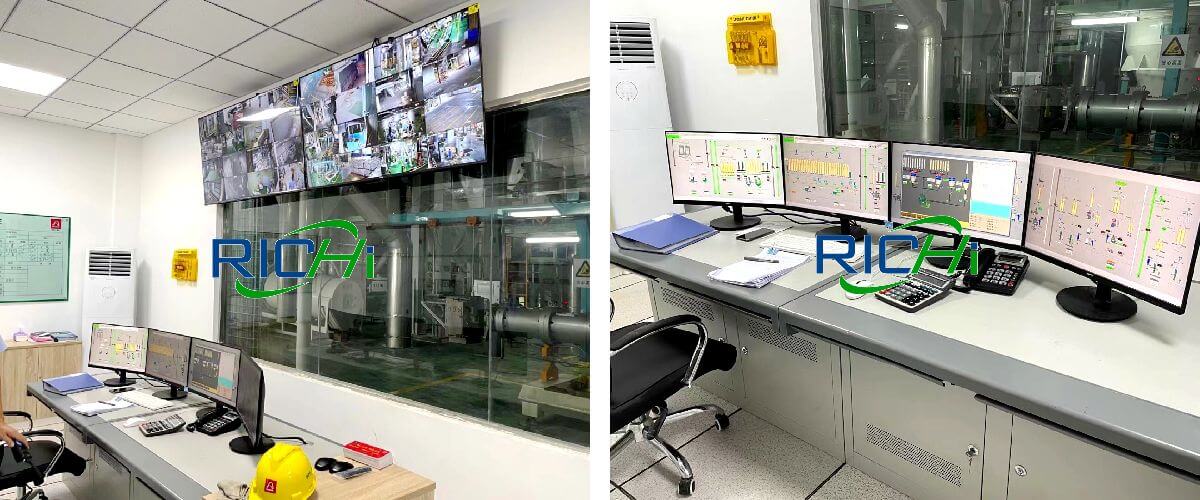
(Frankly speaking, under the premise of the same formula, the quality of the feed pellets made by the extruded pelleting process is better than that of the feed made by the ordinary pelleting process (P<0.01); if the pelleting process is the same, the feed pellets with high starch content and low protein content
The gelatinization degree of the feed pellets prepared by the formula is extremely significantly better than that of the feed prepared by the formula with low starch content and high protein content (P<0.01))
Being the professional supplier worldwide of aqua sinking fish feed machine for the feed industry with more than 30 years of experience, three manufacturing bases, and a global network of sales and service companies, plus a supplementary worldwide distribution network, we are confident in our claim that Richi Machinery is able to supply the optimum technology solution for any possible need in sinking fish feed production plants.